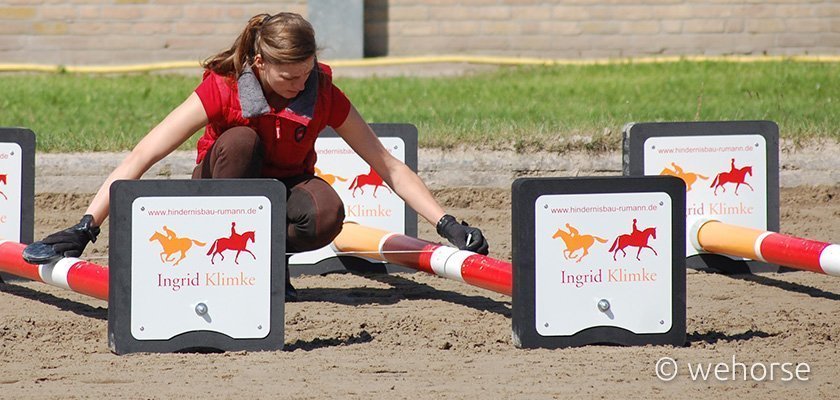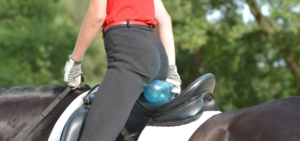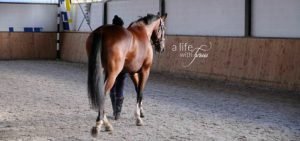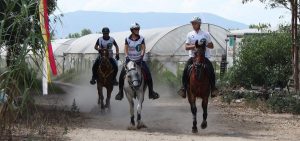Lunging training over poles and Cavaletti is a particularly worthwhile exercise: your horse is stimulated to push off with more intent, ideally with the movement running through the whole body, going over the back and raising the chest.
Summary
- Cavaletti exercises
- How to place the cavalettis
- Getting started
- Trying out different circles
- Trot-canter transitions
- The appropriate height
- Training with a headcollar
- Improving body-awareness
- Building composure
- Our trainer’s approach to training on the lunge
Choosing the appropriate cavaletti set-up
But which exercise set-ups are best for you? And how does one start? Many of us will probably come up with the idea of lunging over three or four cavaletti at a trot. But there’s a lot more you can do!
The best source for good cavaletti training is, of course, Ingrid Klimke. Once a week, she does lunging training over cavaletti with all her horses – this is firmly integrated into the training schedule. This article contains tips from her stable and images from her cavaletti booklet, as well as very different approaches from showjumping trainer Eva Deimel.
With lunging training, how far apart should poles be placed?
Walk poles and cavaletti should be placed at a distance of between 0.80 and 0.90 meters. This distance applies to the inner end, aligned towards the center. They should fan out a bit on the outside. This distance is for large horses. Trot poles and cavaletti should be placed at a distance of between 1.20 and 1.30 meters. Here, too, this measure is for the inside ends, and they fan-out from there. If you want to work at canter, use distances of 2 meters on the inside and 3 meters on the outside.
Warning! These specifications will need to be adapted depending on your horse – a 1.55 meters horse that gets little exercise will naturally smaller dimensions than a horse that is 1.75 meters and gets lots of exercises.
How to get started?
Dressage trainer Claudia Butry likes to start lunging training with only poles and blocks when introducing young horses to cavaletti training. She places one pole on each side of a cavaletti block, with the other end of the pole lying on the ground. She alternates which side is raised, so that one pole is set high on the left and low on the right, and the next will be the opposite. ‘This way the horse has to push off differently.’ For horses that are unfamiliar with pole work she’ll start with two poles at a walk and add more over time. This teaches the horses to look carefully and coordination while walking, prerequisites for beginning actual cavaletti training.

Trying out different circles
At Ingrid Klimke’s stables, every horse learns the many variations of cavaletti training. The horses are ridden over cavaletti sporadically during training and they are also included in the weekly lunging training. It is nice to be able to build cavaletti on two circles! This way the lunging trainer can switch from a circle made of trot cavaletti to a circle of walk cavaletti. The transitions between the gaits are particularly helpful for the relaxation and tensing of muscles, which boosts the training effect.
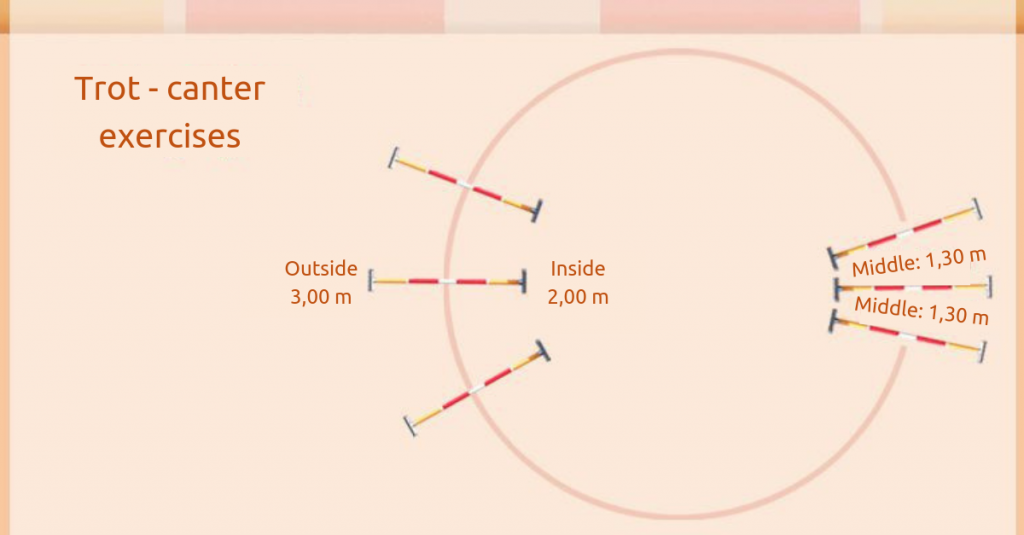
How to work on transitions?
The best way to begin practicing the transition between trot and canter on the lunge is without cavaletti. If this works well and smoothly, you can, for example, canter a half circle after three trot cavaletti and then rein in again to slow down for the trot cavaletti. This is quite a challenge!
After you’ve got the hang of that, you can also place both trot and canter cavaletti on one circle. For example, place three trot cavaletti on one side of the circle and place initially just one canter cavaletti, then two, then three in the opposite side. This lunging training sequence is for advanced students!

How high should the cavalettis be?
It is also important to consider your own training goal! Do I want the horse to trot with expansive movements with an extension posture? Then I’ll choose a greater pole distance than when my goal is clearer push-off with more bent haunches in a working posture. For this the distances must be smaller, and a higher cavaletti height encourages the horse to bend his joints more. If your goal is greater movement, the cavaletti should be placed at somewhat smaller distances.
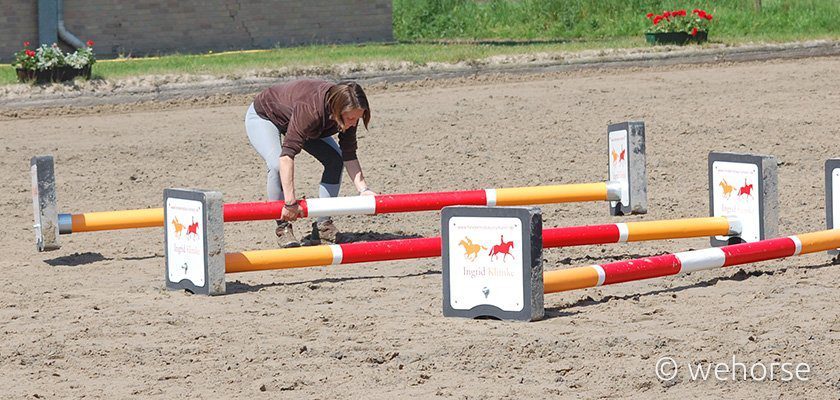
Lunging training on a headcollar
For some riders, lunging your horse on a headcollar is perfectly normal, while for others it’s a mortal sin. After all the outside constraint is missing, so the headcollar can slip forward towards the eye, impairing the effect. But there are good reasons for lunging training with a headcollar. Our jumping instructor Eva Deimel, for example, likes to have her horses jog on a lunge with a headcollar. “I do this to make my horses happy, it’s part of their leisure time!” For the trainer, it does not count as training or work, but as providing a form of relaxation. Nevertheless, they keep proper posture on the lunge. “They don’t gallop after each other, but rather jog with their necks lowered. Even without snaffle bridle and without auxiliary reins!” She is not big on lunging training with cavaletti. That’s also a personal preference, after all. “I prefer to ride my horses in the countryside, ride dressage or do jumping exercises with them,” she says. “They move in the paddock or gallop out in the field – I’m also not into free jumping, I’d rather jump a row of fences in the saddle!” However, Eva Deimel likes to use cavaletti to introduce riders to showjumping.
This is a good example that nothing is mandatory – everyone is allowed to create the best training program for themselves and their horses. And there are many ways to provide variety.
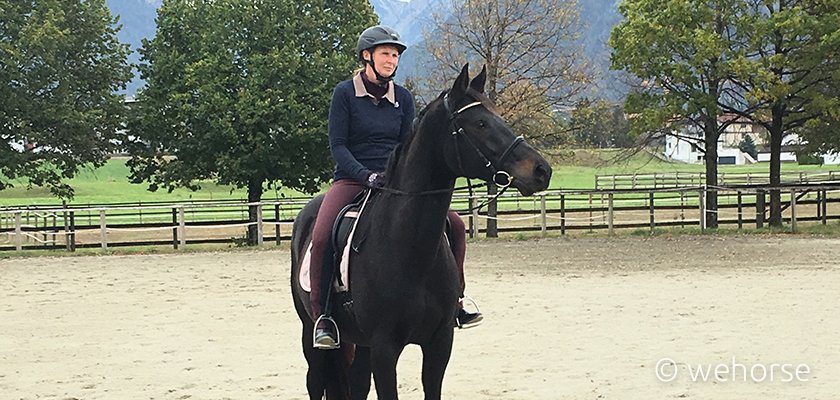
Lunging training exercises for body awareness
Trainer Claudia Butry mainly uses a cavesson for working horses on the lunge – “but it depends on what the horse prefers”. For some of her horses, for example, she uses a Micklem bridle with a nose ring. The bit can be present but has no effect, not being attached to the lunge. She also likes to use cavaletti as anchor points and not for the horse to step over. For example, she’ll place four cavaletti around a circle and then lunge the horse alternately on the circle or around the cavaletti in voltes. This task is quite demanding! “The horse has to be reined in before the circle in tempo, and can then pick up again on the larger circle line to gain momentum.” The lunging trainer moves with the horse and doesn’t stand in the middle of the circle. This exercise of changing between circle and a larger circle line explicitly serves to improve length bend and give the horse a workout.
Building composure when training on the lunge
In order to build a horse’s composure, she also likes to have it walk over a tarpaulin while on the lunge. The tarpaulin is fixed with cones. This helps the horse learn to deal with external stimuli, she explains – a kind of desensitization training. “I do this at a walk or at a trot and canter, depending on how brave the horse is”, she explains. To make it easier for the horse, in the beginning, the tarpaulin is first laid out as a narrow band, “so that the horse can step right over it“. Then it is made wider and wider, so that the tarpaulin rustles when the horse steps on it.
Training on the lunge according to Philippe Karl, Kathrin Roida and Anja Beran.
So you see, there are lots of ideas how the lunging training can train the horse’s mind and body! By the way, we have some great lunging training videos for you to watch which feature very different lunging training approaches, for example from Philippe Karl, Anja Beran, or Kathrin Roida.
Have fun exploring!

